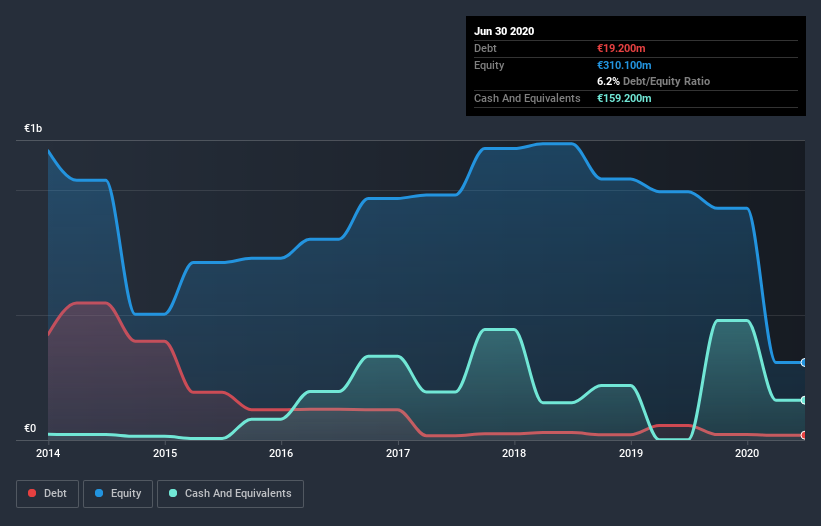David Iben put it well when he said, 'Volatility is not a risk we care about. What we care about is avoiding the permanent loss of capital.' It's only natural to consider a company's balance sheet when you examine how risky it is, since debt is often involved when a business collapses. We note that Esso S.A.F. (EPA:ES) does have debt on its balance sheet. But is this debt a concern to shareholders?
Why Does Debt Bring Risk?
Debt and other liabilities become risky for a business when it cannot easily fulfill those obligations, either with free cash flow or by raising capital at an attractive price. If things get really bad, the lenders can take control of the business. However, a more frequent (but still costly) occurrence is where a company must issue shares at bargain-basement prices, permanently diluting shareholders, just to shore up its balance sheet. Having said that, the most common situation is where a company manages its debt reasonably well - and to its own advantage. The first thing to do when considering how much debt a business uses is to look at its cash and debt together.
Check out our latest analysis for EssoF
What Is EssoF's Net Debt?
The image below, which you can click on for greater detail, shows that EssoF had debt of €19.2m at the end of June 2020, a reduction from €58.1m over a year. But it also has €159.2m in cash to offset that, meaning it has €140.0m net cash.

A Look At EssoF's Liabilities
The latest balance sheet data shows that EssoF had liabilities of €1.28b due within a year, and liabilities of €1.16b falling due after that. Offsetting these obligations, it had cash of €159.2m as well as receivables valued at €500.9m due within 12 months. So its liabilities outweigh the sum of its cash and (near-term) receivables by €1.78b.
This deficit casts a shadow over the €158.8m company, like a colossus towering over mere mortals. So we'd watch its balance sheet closely, without a doubt. After all, EssoF would likely require a major re-capitalisation if it had to pay its creditors today. Given that EssoF has more cash than debt, we're pretty confident it can handle its debt, despite the fact that it has a lot of liabilities in total. There's no doubt that we learn most about debt from the balance sheet. But it is EssoF's earnings that will influence how the balance sheet holds up in the future. So when considering debt, it's definitely worth looking at the earnings trend. Click here for an interactive snapshot.
In the last year EssoF had a loss before interest and tax, and actually shrunk its revenue by 15%, to €13b. We would much prefer see growth.
So How Risky Is EssoF?
While EssoF lost money on an earnings before interest and tax (EBIT) level, it actually generated positive free cash flow €211m. So taking that on face value, and considering the net cash situation, we don't think that the stock is too risky in the near term. We're not impressed by its revenue growth, so until we see some positive sustainable EBIT, we consider the stock to be high risk. The balance sheet is clearly the area to focus on when you are analysing debt. But ultimately, every company can contain risks that exist outside of the balance sheet. Be aware that EssoF is showing 2 warning signs in our investment analysis , and 1 of those is a bit concerning...
If you're interested in investing in businesses that can grow profits without the burden of debt, then check out this free list of growing businesses that have net cash on the balance sheet.
When trading EssoF or any other investment, use the platform considered by many to be the Professional's Gateway to the Worlds Market, Interactive Brokers. You get the lowest-cost* trading on stocks, options, futures, forex, bonds and funds worldwide from a single integrated account. Promoted
Valuation is complex, but we're here to simplify it.
Discover if EssoF might be undervalued or overvalued with our detailed analysis, featuring fair value estimates, potential risks, dividends, insider trades, and its financial condition.
Access Free AnalysisThis article by Simply Wall St is general in nature. It does not constitute a recommendation to buy or sell any stock, and does not take account of your objectives, or your financial situation. We aim to bring you long-term focused analysis driven by fundamental data. Note that our analysis may not factor in the latest price-sensitive company announcements or qualitative material. Simply Wall St has no position in any stocks mentioned.
*Interactive Brokers Rated Lowest Cost Broker by StockBrokers.com Annual Online Review 2020
Have feedback on this article? Concerned about the content? Get in touch with us directly. Alternatively, email editorial-team@simplywallst.com.
About ENXTPA:ES
EssoF
Esso S.A.F. refines, distributes, and markets oil products in France and internationally.
Excellent balance sheet and good value.
Similar Companies
Market Insights
Community Narratives



